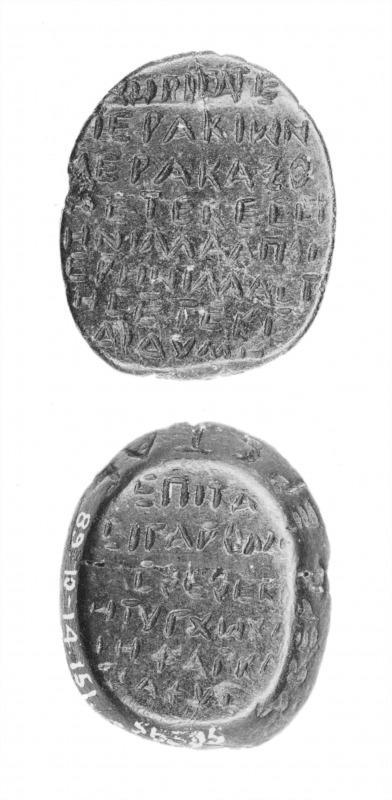Bonner, SMA, 277.
at r. and l., KK, a third kappa lost with the lower part of the stone.
Red jasper. Upright oval, present measurements, 16 X 14.
147
R.O.M.A. C1145
Obv. Ouroboros enclosing uterine symbol with key; no divinities above.
Rev. Nude woman, face indistinct, hair hanging in locks to shoulders, standing to front, knees bent almost to a squatting position, hands pressed to swollen belly. Round margin, beginning at l. above, oυρωρερμιθαθ η oυρωριoυθ ιαιαιαηω. Inner inscription, beginning at l. of woman's head, κατάστιλov. See p. 92.
A carnelian published by Eitrem shows a woman in the same position (Forhandl. i Videnskaρsselskaρet, 1921, 20 and Pl. 2, 12). The writer explains the design as apotropaic, but the word ororiouth on the reverse places it as a uterine amulet. I know no parallel, among stones of that group, for the running dog or jackal on the reverse.
Haematite. Upright oval, 17 X 13.
Unseem Perils and Agressive Magic
148
Obv. Naked man standing to front, head turned to l., hands crossed on chest. A large snake coils round his whole body, its head striking at the back of the man's head. The man is assailed by various creatures; a bird pecks at his eyes, a scorpion attacks the crown of his head, another his phallus, a third his left knee, while a centipede fastens its pincers into each elbow. The bar which serves as the ground line has a knot of cord at its center, perhaps to suggest that his feet are shackled. At left, φθόvε, at right ἀτύχι, i.e. “Bad luck to you, Envy!” The tortured figure personifies Envy, and the stone is an amulet to protect against the evil eye. The design is not known elsewhere as a protection against fascination; but the serpent-wrapped mummies on the so-called Sethianic curse tablets are akin in that they may represent enemies of the person who drew them.
Rev. Plain.
Gray agate. Upright oval, 26 X 19 Χ 3.
149
Obv. Lion-headed god in long tunic, seven rays round head, standing to l., holding cobra in outstretched r. hand, left arm (hand not indicated!) hanging. Under his feet a curious cutting in the stone may be taken to represent a frog if the gem is turned upside down. It does not seem to be a natural flaw or pit.
Rev. Inscription in ten lines (a few uncertain cuts preceding): χυχ βαχυχ βαχαχυχ βαζαχυχυχ βακαξιχυχ βαδητoφωθ ραvχαμωoχ ευλαμω βαιvχωωωχ κατάσχες τoὺς θυμoὺς Tασoι. The last word is entirely on the bevel, and so also are the last two letters of each of the two preceding words.
Serpentine, green with black spots. Upright oval, 20 X 17.
The inscription is a θυμoκάτoχov designed to assuage the anger of a certain Taso or Tasois. The obverse design of the god holding a cobra may have been chosen as symbolizing the control of fierce passions.
150
Obv. Inscription in eight lines: χωρίσατε Ἱερακίωvα ερακαξ ὃv ἔτεκε Σερηvίλλα ἀπὸ Σερηvίλλας τῆς ἔτεκε Διδύμη, “Separate Hierakion...son of Serenilla, from Serenilla, daughter of Didyme.” For the use of article as relative, sporadic in papyri of the Ptolemaic and Roman periods, see Mayser, II, 1, 8.
Rev. ἐπιτάσι γὰρ ὁ μ[ήγα]ς θεὸς κητυγχωχιηφαγκιαφυτ, “For the great god (magical names) commands.” Round bevel .βερβερστας, probably for βερβερετας, a name associated with figures of Bes.
Haematite, upright oval, 24 X 20 X 4.
Last modified: 2012-11-09 11:11:24
Link: cbd.mfab.hu/pandecta/1724



